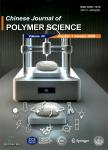CO_2-sensitive Amphiphilic Triblock Copolymer Self-assembly Morphology Transition and Accelerating Drug Release from Polymeric Vesicle
CO_2-sensitive Amphiphilic Triblock Copolymer Self-assembly Morphology Transition and Accelerating Drug Release from Polymeric Vesicle作者机构:College of Chemistry and Chemical Engineering Southwest Petroleum University Engineering Research Center of Oilfield Chemistry Ministry of Education
出 版 物:《Chinese Journal of Polymer Science》 (高分子科学(英文版))
年 卷 期:2018年第36卷第1期
页 面:18-24页
核心收录:
学科分类:1007[医学-药学(可授医学、理学学位)] 081704[工学-应用化学] 07[理学] 08[工学] 0817[工学-化学工程与技术] 070305[理学-高分子化学与物理] 080501[工学-材料物理与化学] 0805[工学-材料科学与工程(可授工学、理学学位)] 0703[理学-化学] 10[医学]
主 题:ATRP CO_2 sensitive Polymeric vesicles Drug release
摘 要:A series of triblock copolymers, containing a CO_2-switchable block poly(2-(dimethylamino)ethyl methacrylate)(PDM) block and two symmetrical hydrophilic blocks polyacrylamide(PAM), were synthesized using atom transfer radical polymerization(ATRP) method. The p H and conductivity tests showed that the triblock copolymer exhibited switchable responsiveness to CO_2, i.e. a relatively low conductivity of solution could be switched on and off by bubbling and removing of CO_2, and the triblock copolymer aqueous solution displayed a CO_2-switchable viscosity variation. The changes were all attributed to protonation of tertiary amine groups in PDM blocks and proven by 1 H-NMR. Cryogenic transmission electron microscopy and dynamic light scattering characterization demonstrated that the viscosity variation was the result of a unilamellar vesicle-network aggregate structure transition. The release of rhodamine B from the vesicles with and without CO_2 stimuli showed the potential application in drug delivery domains; after CO_2 bubbling, the drug release rate could be accelerated. Finally, reasonable mechanism of CO_2-switchable morphology changes and CO_2-induced drug release was proposed.




